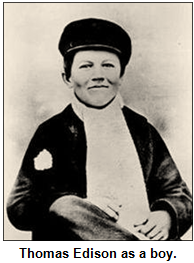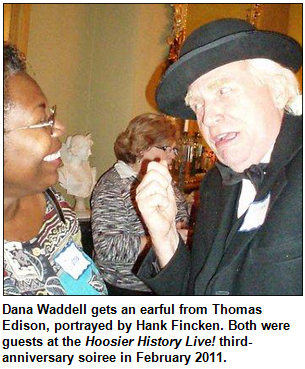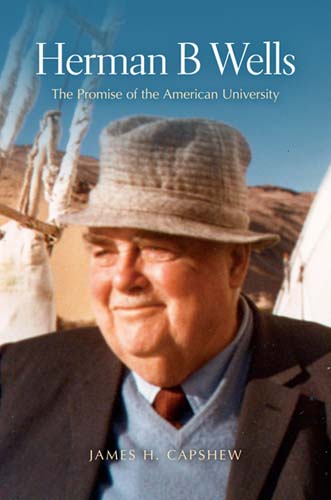May 5 show - web-only encore presentation
Thomas Edison's links to Indiana
Note: The Hoosier History Live! broadcast for May 5 has been pre-empted by WICR for UIndy softball coverage, so we are offering the program in its entirety as a podcast on the Hoosier History Live! website and enewsletter. Thanks to Jed Duvall for quick work in making this podcast possible.
 Are you unaware that one of America's greatest inventors had connections to the Hoosier state? Well, Hoosier History Live! is about to share some, ahem, illuminating info about Thomas A. Edison thanks to a resident expert, Indianapolis-based playwright-performer Hank Fincken.
Are you unaware that one of America's greatest inventors had connections to the Hoosier state? Well, Hoosier History Live! is about to share some, ahem, illuminating info about Thomas A. Edison thanks to a resident expert, Indianapolis-based playwright-performer Hank Fincken.
When the future icon was 17 years old in 1864, Thomas Edison lived in Indianapolis and worked at Union Depot, the forerunner of Union Station, as a telegraph operator. He invented an early machine while living in the Hoosier capital. And - fasten your seat belts - he eventually was fired from his job at Union Depot.
Before that, young Tom Edison had worked in Fort Wayne as a telegrapher. He was fired from that job, too.
What's the back-story about this tumultuous era in the life of Edison (1847-1931), who went on to hold more than 1,000 patents? Tune in as we explore Edison's connections to Indiana and other aspects of his colorful life with Hank, who performs one-man plays across the country "in character" as the famous inventor known for his independent spirit.
 Edison was born in Milan, Ohio, and grew up in Michigan. By the 1860s, when teenage Tom came to Indianapolis, the bustling town was nicknamed "Railroad City" because the depot served as a junction for so many train lines, according to the book Indianapolis Union Station, written in 2000 by James Hetherington. That meant the Western Union railroad telegraph office, where Edison worked, was "busy and important."
Edison was born in Milan, Ohio, and grew up in Michigan. By the 1860s, when teenage Tom came to Indianapolis, the bustling town was nicknamed "Railroad City" because the depot served as a junction for so many train lines, according to the book Indianapolis Union Station, written in 2000 by James Hetherington. That meant the Western Union railroad telegraph office, where Edison worked, was "busy and important."
But Hank shares insights about why things didn't work out in Indy for the future inventor of the incandescent light bulb, the phonograph and so much else that became part of daily life.
"When the reasonable doesn’t work, try the unreasonable," Hank (as Edison) tells audiences.
Regular listeners will recall that Hank has been our guest before. In 2009, he shared insights about the life of John Chapman, who became a folk legend as Johnny Appleseed, another character in Hank's repertoire of historic figures and one-man shows. More info about Hank's plays and performances - including video excerpts of him in costume as Edison - is at hankfincken.com.
Some fun facts:
 After being fired from his Union Depot job in Indianapolis, Tom Edison moved to Cincinnati, then to Louisville. The teenager was fired from jobs in various cities besides Indy and Fort Wayne. Hank will share insights about why young Edison was able to land new jobs despite a string of dismissals in his past.
After being fired from his Union Depot job in Indianapolis, Tom Edison moved to Cincinnati, then to Louisville. The teenager was fired from jobs in various cities besides Indy and Fort Wayne. Hank will share insights about why young Edison was able to land new jobs despite a string of dismissals in his past.- "He learned early on that the real profit was not in the inventing, but in the manufacturing," Hank says.
- Union Depot, which opened in the 1850s in Indianapolis, was the country's first truly "union" train station in which lines from different railroads converged on the same spot. Five competing railroad lines cooperated in building Union Depot, according to a "Culture Watch" column in the Indianapolis Star written by Jim Glass. (Jim was a guest on Hoosier History Live! for a show about another transportation artery, the Old National Road.)
- In the 1880s, ever-increasing requests for accommodations from more railroad lines resulted in the replacement of Union Depot on the site with a massive new Union Station, which, of course, still stands today. Designed in Romanesque Revival architecture, the railroad station became the showplace of Indianapolis as "the Crossroads of America."
- Later in life, Edison, who primarily became based out of New Jersey, enjoyed a romantic correspondence with an Indianapolis woman, according to Hank.
- For most of his life, Edison was hearing-impaired. This didn't stop him from being an audio pioneer, with the phonograph being one of his most important inventions. According to Hank, the genius inventor resisted dabbling in the early radio industry because he was convinced listeners would want to select their own music rather than having it chosen for them by broadcast stations.
- During the 1890s, Edison became a pioneer in early motion pictures. Although "flickers" were silent then, Hank says Edison always knew movies eventually would "talk."
Because this is an encore presentation of a show that originally aired on May 14, 2011, there will be no live call-in for the History Mystery.
Your Hoosier History Live! team,
Nelson Price, host and creative director
Molly Head, producer, (317) 927-9101
Chris Gahl, Roadtripper
Richard Sullivan, webmaster and tech director
Pam Fraizer, graphic designer
Garry Chilluffo, creative consultant
Michele Goodrich, Jed Duvall, grant consultants
Joan Hostetler, photo historian
Dana Waddell, volunteer-at-large
www.hoosierhistorylive.org




Please tell our sponsors that you appreciate their support: Aesop's Tables, Indiana Historical Society, Lucas Oil and Story Inn.
 Acknowledgments to Print Resources, Indianapolis Marion County Public Library, Monomedia, Indiana Humanities, Indianapolis Convention & Visitors Association, WICR-FM, Fraizer Designs, Heritage Photo and Research Services, Derrick Lowhorn, Samantha Stratton and many other individuals and organizations. We are an independently produced program and are self-supporting through organizational sponsorships, grants and through individual tax-deductible contributions through the Indiana Humanities Council. Visit our website to learn how you can support us financially.
Acknowledgments to Print Resources, Indianapolis Marion County Public Library, Monomedia, Indiana Humanities, Indianapolis Convention & Visitors Association, WICR-FM, Fraizer Designs, Heritage Photo and Research Services, Derrick Lowhorn, Samantha Stratton and many other individuals and organizations. We are an independently produced program and are self-supporting through organizational sponsorships, grants and through individual tax-deductible contributions through the Indiana Humanities Council. Visit our website to learn how you can support us financially.
May 12 show - encore presentation
Remarkable life of Herman B Wells
For six generations, he was “Mr. I.U.”, the pre-eminent personality associated with the Bloomington campus of Indiana University.  Beloved for his jovial disposition and nationally acclaimed as a visionary, Herman B Wells had a glorious life, but also a much more complex one than many admirers realized.
Beloved for his jovial disposition and nationally acclaimed as a visionary, Herman B Wells had a glorious life, but also a much more complex one than many admirers realized.
As an eagerly anticipated new biography points out, a pattern of suicides ran in the family of the rotund, gregarious educator, whom many Hoosiers likened to Santa Claus. (During his run as IU president from the 1930s to the early 1960s - and then for an additional 35 years as the chancellor - Herman B Wells donned a white beard to portray St. Nick during holiday seasons.)
To explore the long life (1902-2000) of the man whose other nicknames included “Hermie,” Nelson will be joined in studio by James Capshew, who first met the legendary figure when he was hired in the late 1970s to work as the chancellor’s houseboy. Today, Jim is an associate professor of history and philosophy of science at IU, as well as the author of Herman B Wells (IU Press), a biography that also describes social history as it unfolded during the 97 years that Dr. Wells lived.
Jim’s book details Herman B Wells’ stealth-like, crucial roles in racially integrating aspects of IU ranging from the Commons dining facility in the student union to the basketball court and the swimming pool.
Dr. Wells also used his clout to defend sex researcher Alfred Kinsey, whose work at IU came under fire in the 1950s. Describing Herman B Wells as “empathetic, shrewd and charming,” Jim Capshew writes, “Wells built an institution, and, in the process, became one himself.”
When Wells, a native of Boone County, arrived as a student at IU in 1921, the student body totaled 2,500; more than 90 percent were from Indiana. The size and demographics of the student body – along with a staggering array of other aspects of I.U. – were about to be transformed.
© 2012 Hoosier History Live! All rights reserved.